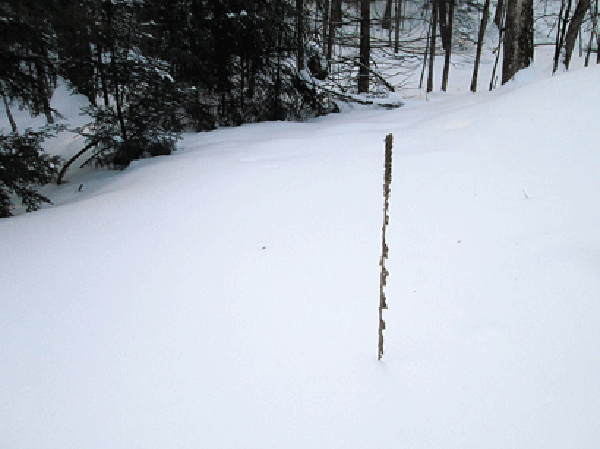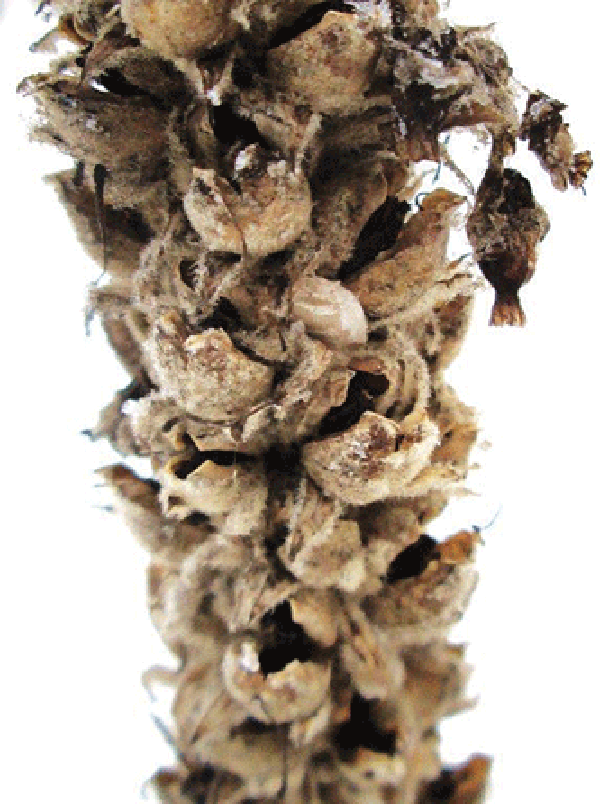Mullein

Something in the quality of the pre-dawn light told me that the world had been made new with a fresh blanket of snow. I love waking up to a clean slate. What furry or feathered stories will lay their tracks on it today? Artists, with their warmer, drier canvases, must have the same feelings of anticipation and eagerness to see a new creation emerge. As a child, I felt that way on the first day of school, too, with my stack of blank notebooks, ready for a new adventure.
Even as the sun rose, there was already one mark in the snowy expanse of my front “yard”. Sticking out of the snow like a proud sentinel was the dried stalk from a common mullein plant. I’ve been watching it since last summer, when its yellow-flowered stalk was just a dab of color among daylilies, black-eyed Susans, and daisies. Today it was the center of attention while all of its companions lay resting under the weight of the drifts.
Although this mullein stalk is just as dead (actually, even more dead) as its dormant neighbors, its sturdy, dry stem gives it a second life. This plant began during the summer before last, when a tiny seed found enough sunlight and bare soil to sprout. Mullein likes disturbed areas. Soon, a low circle of leaves, called a basal rosette, spread out on the earth. This biennial overwintered that way, with its leaves and roots hidden beneath the snow. A period of cold and dormancy is required to break down starch in the roots and trigger its next life stage.
In the spring, a thick stalk began to grow out of the basal rosette’s center. Once the spire was chest-high, the lowest flowers, starting about half-way up the stalk, began to blossom in small clusters. Small and yellow, with five symmetrical petals, each flower only bloomed for a single day. It opened before dawn and closed in the afternoon. If a bee didn’t pollinate the flower during that short window, the flower did the job itself. With such measured restraint, a single stalk of mullein can bloom for an entire summer.
Once that summer is over, though, the mullein is done. Each plant only lives through two growing seasons, while the durable, dried stalk persists much longer.
Chickadees scattered from the bird feeder as I tromped outside to take a closer look at my sentinel in the snow. Up close, I could see tiny, roundish seed capsules split open down a center seam and clustered among the few dried flower petals still clinging to the top of the spike. Each of the hundreds of capsules can hold more than 700 seeds, each less than a millimeter long.

The flower stalk’s usefulness doesn’t end after it goes to seed, though. Mullein is a notoriously useful plant among survivalists and other wildcrafters. For one, it provides everything you need to start a fire. The lower portion of the stalk becomes a spindle for a hand drill or bow drill. The thick base of big stalks can be split and used for the fireboard that rests on the ground and holds the spindle and eventual ember. The tough root can be fashioned into a hand socket for pressing down on the top of the spindle when using a bow drill.
Once you get a hot coal, mullein leaves make excellent tinder. Held vertically on the stalk all winter, they are often dry when everything else is wet. Plus, their fuzzy texture provides ample surface area to ignite. Once you’ve coaxed a little flame, the uppermost club of seed capsules is useful as kindling.
That’s just the beginning. The flowers will make a yellow dye. Many parts of the plant are considered medicinal, especially for upper respiratory ailments. The seeds are not edible, but contain chemicals used to stun fish. The fuzzy leaves can be soaked in fat and made into candle wicks or torches, or laid in your shoes for cushioning, or rubbed on your cheeks for “Quaker rouge.” Turns out, the tiny hairs are a skin irritant. They can either make you a blushing beauty, or give you contact dermatitis. Beware of the wide basal leaves’ other use as “cowboy toilet paper.”
While mullein isn’t native here (Europe, northern Africa, and Asia are its home range), it has spread quickly since the 1700s, and is considered naturalized in most places. Native species as well as other newcomers find it useful, and it only threatens to take over where other plants are sparse.
As I stooped near the flower stalk for a photo, another use caught my eye. Hidden among the seed capsules was a single, hulled sunflower seed: the food cache of a chickadee.
Leaning even closer, I bumped the stalk and sent a shower of tiny black seeds onto the snow. They are too small for the chickadees to bother with, but goldfinches have been known to eat them.
Most of the seeds will likely settle into the soil when the snow melts. With characteristic restraint, the seeds can persist for up to a hundred years. They wait for just the right conditions to sprout a new basal rosette and begin again. Their requirements? Bare soil, full sun: a clean slate on which to begin something new.
For over 45 years, the Cable Natural History Museum has served to connect you to the Northwoods. Come visit us in Cable, WI! Our new exhibit: “Lake Alive!” opened May 1, 2015, and will remain open until March 2016.
Find us on the web at www.cablemuseum.org to learn more about our exhibits and programs. Discover us on Facebook, or at our blogspot, http://cablemuseumnaturalconnections.blogspot.com.
